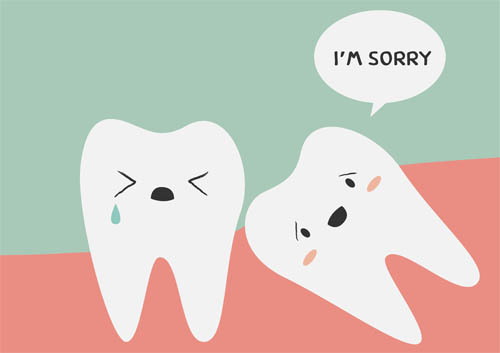January 30th, 2015

Oral hygiene has always been an important part of maintaining overall health. For thousands of years, humans have found ways to keep their teeth and mouths clean. According to the American Dental Association (ADA), “early forms of the toothbrush have existed for nearly 5,000 years.” But what exactly did the first toothbrush look like?
Toothbrush Timeline
With help from The Library of Congress, Dr. Paul Rosel and our team have compiled a timeline with some interesting details about the evolution of the toothbrush:
- 3000 BC – Perhaps the earliest form of the toothbrush, the “chew stick” was used by Ancient civilizations. People would rub this thin twig with a frayed end against their teeth to remove food and plaque.
- 1498 – The bristle toothbrush was invented in China and had many similarities to the toothbrushes used today. These devices were made by attaching the stiff, coarse hairs from the back of a hog’s neck to handles that were typically made from bone or bamboo.
- 1938 – Signaling the end of the boar bristle, Dupont de Nemours introduced nylon bristles, and Americans welcomed Doctor West’s Miracle Toothbrush, the first nylon toothbrush.
- 1960 – The Squibb Company introduced Broxodent, one of the first electric toothbrushes, to the American market.
Toothbrushes Today
Today, there are many brands of toothbrushes that often advertise different benefits. The variety of options may seem overwhelming, but the most important thing is for you to find a toothbrush that you like and find easy to use.
The ADA recommends that you choose a toothbrush that fits comfortably and allows you to effectively reach all areas of your mouth. Whether you decide to use a manual or a powered toothbrush, make sure that you thoroughly clean all surfaces of your teeth twice a day.
Society has come a long way since the days of the chew stick, but one thing that remains the same is the importance of consistent and effective personal oral hygiene.
January 23rd, 2015

As you grow older, your mind may be preoccupied with the health of your bones, heart, or brain. However, our team at Paul D. Rosel, D.D.S. LLC Family and Cosmetic Dentistry will tell you that keeping your teeth healthy is an equally important part of the aging process. Older adults are at increased risk for a variety of oral health conditions, which makes it essential for you to speak with your dentist to create a prevention plan that’s best for you.
Oral health conditions associated with aging
Just as the rest of your body continues to change as you age, your mouth changes, too. Certain conditions become more likely to develop as you reach older adulthood, including:
- Dry mouth. Although your salivary glands continue to produce saliva as you get older, medications and chronic health problems often cause dry mouth.
- Root decay. Your teeth have lasted you a lifetime, but improper nutrition or cleaning may lead to decay at the roots of your teeth.
- Diminished sense of taste. Your eyesight and hearing aren’t the only senses affected by aging. The ability to taste naturally diminishes over the course of older adulthood.
- Tissue inflammation. Are your gums tender, bleeding, or inflamed? Tissue inflammation may indicate gum disease or may be a consequence of wearing dentures that don’t fit well.
- Oral cancer. Risk for most cancers increases with age, and oral cancer is no exception. Older adults are at increased risk for oral cancer compared to younger individuals.
Ways you can prevent dental problems
Fortunately, many age-related oral health problems are preventable. Begin by improving your diet to include plenty of fruits and vegetables. Choosing water over coffee or soda will keep your teeth whiter and cavity-free. Also remember to practice good brushing habits to prevent cavities and gum disease.
Visiting the dentist at least twice a year is vitally important when you reach older adulthood. Your dentist is familiar with your oral health and may be the first person to notice a sore, discolored patch, inflammation, or other abnormality that indicates oral cancer or gum disease.
If you’re experiencing any problems with dental health, let your dentist know immediately. Together, you can troubleshoot solutions and create a plan that keeps your mouth and gums healthy.
For more information, or to schedule an appointment with Dr. Paul Rosel, please give us a call at our convenient Olathe, KS office!
January 16th, 2015

Also known as onchophagia, the habit of nail biting is one of the so-called “nervous habits” that can be triggered by stress, excitement, or boredom. Approximately half of all kids between the ages of ten and 18 have been nail biters at one time or another. Experts say that about 30 percent of children and 15 percent of adults are nail biters, however most people stop chewing their nails by the time they turn 30.
Here are four dental and general reasons to stop biting your nails:
1. It’s unsanitary: Your nails harbor bacteria and germs, and are almost twice as dirty as fingers. What’s more, swallowing dirty nails can lead to stomach problems.
2. It wears down your teeth: Gnawing your nails can put added stress on your pearly whites, which can lead to crooked teeth.
3. It can delay your orthodontic treatment: For those of our patients wearing braces, nail biting puts additional pressure on teeth and weakens roots.
4. It can cost you, literally: It has been estimated that up to $4,000 in extra dental bills can build up over a lifetime.
Dr. Paul Rosel and our team recommend the following to kick your nail biting habit:
- Keep your nails trimmed short; you’ll have less of a nail to bite.
- Coat your nails with a bitter-tasting nail polish.
- Ask us about obtaining a mouthguard, which can help prevent nail biting.
- Put a rubber band around your wrist and snap it whenever you get the urge to gnaw on your nails.
- Think about when and why you chew your nails. Whether you are nervous or just bored, understanding the triggers can help you find a solution and stop the habit.
- If you can’t stop, behavioral therapy may be an effective option to stop nail biting. Ask Dr. Paul Rosel and our team for a recommendation.
January 9th, 2015

When your wisdom teeth start to emerge it can definitely be painful, but it can be even worse if your wisdom teeth become impacted. Impacted wisdom teeth are trying to erupt but are unable to do so because there is not sufficient room for them to emerge. This usually means that your wisdom teeth are painfully lodged in your jawbone.
While you may not see any real signs of the emerging wisdom teeth when they are impacted, what you can’t see can still definitely hurt you. Some of the indicators of impacted wisdom teeth are listed below.
- Jaw Pain: Pain in the back of your jaw is a common indicator of impacted wisdom teeth. The pain often concentrates in the area around your gums.
- Changes in the Mouth: You may notice some changes in your mouth when you have impacted wisdom teeth. Reddish gums, swelling in the jaw, bleeding gums, and bad breath can all be indicators that you are dealing with impacted wisdom teeth.
- Headaches: If you suddenly start having headaches, especially at the same time as some of the other issues mentioned above, they may indicate impacted wisdom teeth.
- Chewing Issues: Problems with chewing normally can indicate impacted wisdom teeth. If you are having trouble making the chewing motions because your mouth won’t quite open and close as easily as it used to, impacted wisdom teeth may be the culprit.
The Solution
If you are suffering from impacted wisdom teeth, the best solution is usually going to be removal. This is not a problem that will resolve naturally, and in fact, your pain and other symptoms may worsen as your wisdom teeth become increasingly impacted. At Paul D. Rosel, D.D.S. LLC Family and Cosmetic Dentistry, Dr. Paul Rosel can review the details of wisdom teeth removal surgery with you and help you determine if this is the best solution for your situation.




